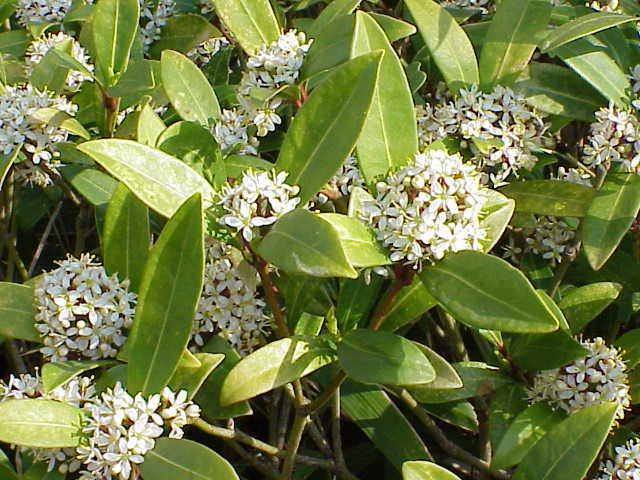- Rutaceae
Taxobox
name = Rutaceae

image_caption = "Skimmia japonica"
regnum =Plantae
unranked_divisio =Angiosperms
unranked_classis =Eudicots
unranked_ordo =Rosids
ordo =Sapindales
familia = Rutaceae
familia_authority = Juss., 1789
subdivision_ranks = Genera
subdivision =About 160, totaling over 1600 species. SeeList of Rutaceae genera Rutaceae, commonly known as the Rue or Citrus family, is a family of
plant s, usually placed in the orderSapindales .Species of the family generally have
flower s that divide into four or five parts, usually with strong scents. They range in form and size fromherb s toshrub s and smalltree s.The most economically important
genus in the family is "Citrus ", which includes the orange ("C. sinensis"),lemon ("C." × "limon"),grapefruit ("C. paradisi"), and lime (various, mostly "C. aurantifolia", thekey lime ). "Boronia " is a large Australian genus, some members of which are plants with highly fragrant flowers and are used in commercial oil production. Other large genera include "Zanthoxylum " and "Agathosma ".Characteristics
Most species are trees or shrubs, a few are herbs ("
Boenninghausenia "), frequently aromatic withgland s on theleaves , sometimes with thorns. The leaves are usually opposed and compound, and withoutstipule s.Flowers are
bract less, solitary or incyme , rarely inraceme , and mainly pollinated by insects. They are radially or (rarely) laterally symmetric, and generally hermaphroditic. They have four or fivepetal s andsepal s, sometimes three, mostly separate, eight to tenstamen (five in "Skimmia ", many in "Citrus "), usually separate on in several groups. Usually a single stigma with 2 to 5 unitedcarpel s, sometimes ovaries separate and styles combined.The fruit of Rutaceae are very variable:
berries ,drupe s,hesperidium s, samara, capsules and follicles all occur. Seed number also varies widely.Classification
The family is closely related to
Sapindaceae ,Simaroubaceae andMeliaceae , and all are usually placed into the same order, although some systems separate that order intoRutales andSapindales . The familiesFlindersiaceae andPtaeroxylaceae are sometimes kept separate, but nowadays generally placed in Rutaceae, as are the formerCneoraceae . The subfamilial organization has not been fully resolved, but the subfamilies Citroideae (=Aurantioideae) and Rutoideae are well supported; the placement of several genera remains unclear.Notable species
The family is of great economic importance under tropical climates for its numerous edible fruits of the "
Citrus " genus, such as the orange, lime,kumquat ,mandarine andgrapefruit . Non-citrus fruits include theWhite sapote ("Casimiroa edulis") and thebael ("Aegle marmelos"). Other plants are grown inhorticulture : "Murraya " species, for example. "Ruta ", "Zanthoxylum " and "Casimiroa " species are medicinals. Several plants are also used by theperfume industry, such as the Western Australian "Boronia megastigma ".References
*cite book |last=Singh |first=Gurjaran |title=Plant Systematics: An Integrated Approach |year=2004 |publisher=Science Publishers |location=Enfield, New Hampshire |isbn=1-57808-342-7| pages=pp. 438-440
*cite journal |last=Chase |first=Mark W. |coauthors=Cynthia M. Morton & Jacquelyn A. Kallunki |year=1999 |month=August |title=Phylogenetic relationships of Rutaceae: a cladistic analysis of the subfamilies using evidence from RBC and ATP sequence variation |journal=American Journal of Botany |volume=86 |issue=8 |pages=1191–1199 |url=http://www.amjbot.org/cgi/content/full/86/8/1191|accessdate=2007-08-30 |doi=10.2307/2656983 |pmid=10449399External links
*commonscat-inline|Rutaceae
Wikimedia Foundation. 2010.
